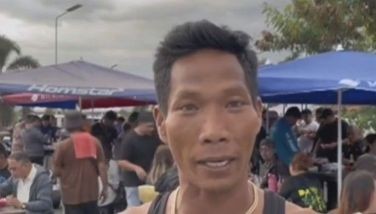Cotabato City rises from conflict
June 19, 2006 | 12:00am
COTABATO CITY — While the Mindanao secessionist conflict has unduly projected Cotabato City as a hotbed of the Moro uprising, it is just a small part of the troubled south and local residents are struggling to thrive in unity despite the diversity in culture, religion, political convictions and ethnic identities.
It was in 1936 when the first municipal hall here was built at the foot of Kuta Wato, a legendary stone fort which Sultan Kudarat, a 17th century warrior, used as a launching pad for attacks against Spaniards guarding their galleons moored on the banks of the Rio Grande de Mindanao.
Local residents will inaugurate tomorrow or exactly 70 years later the 9,000-square-meter "People’s Palace," or the new city hall, which will be a venue for inter-faith, cross-section dialogues.
The opening to the public of the newly built, P82-million People’s Palace will coincide with the 47th founding anniversary of Cotabato as a chartered city.
The city was the main entry point or gateway to many areas in Central Mindanao, for settlers from Luzon and Visayas during the 1930s and the after World War II.
"The old Cotabato then was crisscrossed only by trails for animal-drawn carts and there were only about a dozen buildings in the town proper with G.I. roofs," said physician Ramon Rabago Jr., a second generation member of the pioneer Rabago family here, which traces roots to Ilocos Norte.
Rabago’s father, Ramon Sr., was one of the first nine doctors to arrive here in the 1930s as "doctors to the barrio," who did not just practice medicine but performed embalming as well due to the absence of a funeral facility in the city.
The mayor here, Datu Muslimin Sema, has vivid memories of how his father, Datu Kalantungan, one of the early leaders in what is now Barangay Kakar here, would hike from their ancestral home to the city plaza to play chess with his Christian friends, among them Spanish landlords, right at the ramp of a statue of Dr. Jose Rizal.
"If we study the history of Cotabato City, there was no animosity really between Christian and Muslim residents," the mayor said.
Cotabato City made headlines in the early 1970s with the outbreak of the Mindanao Moro rebellion and the deadly earthquake that struck in 1977.
Contemporary historians, however, said it was the use of Cotabato City as dateline for reports on hostilities in surrounding provinces by correspondents of national dailies then that destroyed the city’s image as a peaceful community and one of the historic seats of the Maguindanaon royalty.
It was actually in Marawi City where the first shots fired in 1971 by Moro secessionist guerrillas were heard, when they stormed the Mindanao State University campus, took over a radio station there and played martial songs for two days until government forces from Iligan and Cagayan de Oro arrived to drive them away.
The first recorded Moro-military encounters nearest to Cotabato City were in Barangay Garigayan in Buldon, a hinterland town in Maguindanao where pro-independence rebels, led by Bangon Aratuc, figured in a spate of sporadic, but bloody clashes with members of the defunct Philippine Constabulary for more than a month, which resulted in the displacement of thousands of civilians in the municipality.
Cotabato City, as Central Mindanao’s trading hub, became the biggest evacuation center for displaced residents in Maguindanao when Moro-military hostilities erupted into a full-blown uprising, following former President Ferdinand Marcos’ declaration of martial law in 1972.
In the early 1990s, Cotabato City was dubbed the kidnapping capital of the South as a result of the activities of a gang led by Abugado Bago, more known as Commander Mubarak, who was implicated in the abduction of 46 traders here, mostly Filipino-Chinese settlers.
But Mubarak and his men were rouge rebels from different towns in Maguindanao and Sultan Kudarat. They merely pulled off kidnappings in the city and spirited all of their 46 victims to other provinces where it was difficult for the military and police to track them down.
In a random survey, 26 of 30 Chinese traders here agree that the city has indeed been just bouncing back from the devastations wrought by the Mindanao conflict in the 1970s and, most importantly, from the transfer to Koronadal City three years ago of the administrative seat of Region 12.
"The transfer to Koronadal City of the capital of Region 12 was a sad chapter in the history of commerce and trade in Cotabato City. Fortunately, we have overcome the ordeal and we are now coping up," said a Chinese hardware store owner here who asked not to be identified.
Worse, the transfer of the seat of Region 12 came two years after the devastation of the local economy by former President Estrada’s military adventurism in 2000, where the government took over 44 "main and minor camps" of the Moro Islamic Liberation Front (MILF) , including its supposed main bastion, Camp Abubakar, where the MILF had showcased its concept of a puritan Islamic community.
The liberation of many areas in Central Mindanao from MILF occupation resulted in the displacement of some 200,000 poor civilians, mostly marginalized villagers in Maguindanao, North Cotabato, Sultan Kudarat and Lanao del Sur.
Sema, the mayor here since 1998, said there have been more than 400 applications for business permits in the city in the past two years.
The city has 14 banks, more than a dozen big hotels and about a hundred restaurants, some established after the city was stripped of its geographical identity as administrative and political capital of Region 12.
A recent study even showed a 10,000 vehicle-load on the city’s thoroughfares everyday since 2002.
Among those helping restore socio-economic and political normalcy in the city are local Muslim clerics and leaders of the Christian community, among them Cotabato Archbishop Orlando Quevedo, known for his advocacy of Muslim-Christian ecumenical peace dialogues.
Cotabato City, no doubt, is rising from conflict, but how long will its people wait for tranquility and sustainable development to fully spread throughout the vast Central Mindanao is a question every peace advocate must ponder on.
It was in 1936 when the first municipal hall here was built at the foot of Kuta Wato, a legendary stone fort which Sultan Kudarat, a 17th century warrior, used as a launching pad for attacks against Spaniards guarding their galleons moored on the banks of the Rio Grande de Mindanao.
Local residents will inaugurate tomorrow or exactly 70 years later the 9,000-square-meter "People’s Palace," or the new city hall, which will be a venue for inter-faith, cross-section dialogues.
The opening to the public of the newly built, P82-million People’s Palace will coincide with the 47th founding anniversary of Cotabato as a chartered city.
The city was the main entry point or gateway to many areas in Central Mindanao, for settlers from Luzon and Visayas during the 1930s and the after World War II.
"The old Cotabato then was crisscrossed only by trails for animal-drawn carts and there were only about a dozen buildings in the town proper with G.I. roofs," said physician Ramon Rabago Jr., a second generation member of the pioneer Rabago family here, which traces roots to Ilocos Norte.
Rabago’s father, Ramon Sr., was one of the first nine doctors to arrive here in the 1930s as "doctors to the barrio," who did not just practice medicine but performed embalming as well due to the absence of a funeral facility in the city.
The mayor here, Datu Muslimin Sema, has vivid memories of how his father, Datu Kalantungan, one of the early leaders in what is now Barangay Kakar here, would hike from their ancestral home to the city plaza to play chess with his Christian friends, among them Spanish landlords, right at the ramp of a statue of Dr. Jose Rizal.
"If we study the history of Cotabato City, there was no animosity really between Christian and Muslim residents," the mayor said.
Cotabato City made headlines in the early 1970s with the outbreak of the Mindanao Moro rebellion and the deadly earthquake that struck in 1977.
Contemporary historians, however, said it was the use of Cotabato City as dateline for reports on hostilities in surrounding provinces by correspondents of national dailies then that destroyed the city’s image as a peaceful community and one of the historic seats of the Maguindanaon royalty.
It was actually in Marawi City where the first shots fired in 1971 by Moro secessionist guerrillas were heard, when they stormed the Mindanao State University campus, took over a radio station there and played martial songs for two days until government forces from Iligan and Cagayan de Oro arrived to drive them away.
The first recorded Moro-military encounters nearest to Cotabato City were in Barangay Garigayan in Buldon, a hinterland town in Maguindanao where pro-independence rebels, led by Bangon Aratuc, figured in a spate of sporadic, but bloody clashes with members of the defunct Philippine Constabulary for more than a month, which resulted in the displacement of thousands of civilians in the municipality.
Cotabato City, as Central Mindanao’s trading hub, became the biggest evacuation center for displaced residents in Maguindanao when Moro-military hostilities erupted into a full-blown uprising, following former President Ferdinand Marcos’ declaration of martial law in 1972.
In the early 1990s, Cotabato City was dubbed the kidnapping capital of the South as a result of the activities of a gang led by Abugado Bago, more known as Commander Mubarak, who was implicated in the abduction of 46 traders here, mostly Filipino-Chinese settlers.
But Mubarak and his men were rouge rebels from different towns in Maguindanao and Sultan Kudarat. They merely pulled off kidnappings in the city and spirited all of their 46 victims to other provinces where it was difficult for the military and police to track them down.
In a random survey, 26 of 30 Chinese traders here agree that the city has indeed been just bouncing back from the devastations wrought by the Mindanao conflict in the 1970s and, most importantly, from the transfer to Koronadal City three years ago of the administrative seat of Region 12.
"The transfer to Koronadal City of the capital of Region 12 was a sad chapter in the history of commerce and trade in Cotabato City. Fortunately, we have overcome the ordeal and we are now coping up," said a Chinese hardware store owner here who asked not to be identified.
Worse, the transfer of the seat of Region 12 came two years after the devastation of the local economy by former President Estrada’s military adventurism in 2000, where the government took over 44 "main and minor camps" of the Moro Islamic Liberation Front (MILF) , including its supposed main bastion, Camp Abubakar, where the MILF had showcased its concept of a puritan Islamic community.
The liberation of many areas in Central Mindanao from MILF occupation resulted in the displacement of some 200,000 poor civilians, mostly marginalized villagers in Maguindanao, North Cotabato, Sultan Kudarat and Lanao del Sur.
Sema, the mayor here since 1998, said there have been more than 400 applications for business permits in the city in the past two years.
The city has 14 banks, more than a dozen big hotels and about a hundred restaurants, some established after the city was stripped of its geographical identity as administrative and political capital of Region 12.
A recent study even showed a 10,000 vehicle-load on the city’s thoroughfares everyday since 2002.
Among those helping restore socio-economic and political normalcy in the city are local Muslim clerics and leaders of the Christian community, among them Cotabato Archbishop Orlando Quevedo, known for his advocacy of Muslim-Christian ecumenical peace dialogues.
Cotabato City, no doubt, is rising from conflict, but how long will its people wait for tranquility and sustainable development to fully spread throughout the vast Central Mindanao is a question every peace advocate must ponder on.
BrandSpace Articles
<
>
- Latest
- Trending
Trending
Latest
Trending
Latest
Recommended




























